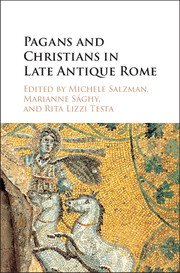 Pagans and Christians in Late Antique Rome
Pagans and Christians in Late Antique Rome Book contents
- Frontmatter
- Contents
- List of Illustrations
- Biographies of Authors
- Acknowledgments
- Introduction
- Part I SENATORIAL POLITICS AND RELIGIOUS CONFLICT
- Part II The Construction of New Religious Identities
- Part III Pagans and Christians: Coexistence and Competition
- Section A Pagans and Religious Practices in Christian Rome
- 8 Reinterpreting the Cult of Mithras
- 9 Napkin Art: Carmina contra paganos and the Difference Satire Made in Fourth-Century Rome
- 10 Poetry and Pagans in Late Antique Rome: The Case of the Senator “Converted from the Christian Religion to Servitude to the Idols”
- 11 Professiones Gentiliciae: The Collegia of Rome between Paganism and Christianity
- Section B Death and the Afterlife
- Section C Reading Religious Iconography as Evidence for Pagan–Christian Relations
- Concluding Remarks: Vrbs Roma between Pagans and Christians
- Index
- References
8 - Reinterpreting the Cult of Mithras
from Section A - Pagans and Religious Practices in Christian Rome
Published online by Cambridge University Press: 05 November 2015
- Frontmatter
- Contents
- List of Illustrations
- Biographies of Authors
- Acknowledgments
- Introduction
- Part I SENATORIAL POLITICS AND RELIGIOUS CONFLICT
- Part II The Construction of New Religious Identities
- Part III Pagans and Christians: Coexistence and Competition
- Section A Pagans and Religious Practices in Christian Rome
- 8 Reinterpreting the Cult of Mithras
- 9 Napkin Art: Carmina contra paganos and the Difference Satire Made in Fourth-Century Rome
- 10 Poetry and Pagans in Late Antique Rome: The Case of the Senator “Converted from the Christian Religion to Servitude to the Idols”
- 11 Professiones Gentiliciae: The Collegia of Rome between Paganism and Christianity
- Section B Death and the Afterlife
- Section C Reading Religious Iconography as Evidence for Pagan–Christian Relations
- Concluding Remarks: Vrbs Roma between Pagans and Christians
- Index
- References
Summary
One of the basic assumptions of Mithraic studies has, since the inception of the discipline, been that the cult of Mithras in late antique Rome represented at the very least a break with traditional cult practices of the preceding two centuries, and in the most radical interpretation a contaminated and devolved version of the original ideology and practice struggling to maintain its identity in a religious landscape where Christianity was in ascendancy. However, late antique Mithraism has not, with a few notable exceptions, received much serious attention from scholars of ancient religion. Mithraism in Rome in this period is still often described as essentially the subject of a failed, politically motivated resurrection of long-dead cult practices in the last decades of the fourth century by a segment of the senatorial elite. Mithraic cult rooms have been described as long-abandoned spaces, mostly destroyed by Christian mobs as a result of fierce competition and religiously motivated violence, before eventually every last vestige of the cult was annihilated. This turn of events has little, if anything, to do with the actual source material, and when this evidence is reexamined and analyzed in its proper context, a very different view of the late antique cult in Rome emerges.
Over the past decade or so, however, new archaeological finds as well as several new studies of previously understudied categories of Mithraic remains carry great potential for new chronological and contextual studies of the cult. Access to new evidence as well as a critical reevaluation of both primary and secondary sources clearly shows a picture of continuity rather than decline, and it is clear that an empire-wide reinterpretation of the cult of Mithras in late antiquity is in order. In this chapter, however, I will limit myself to discussing the Mithraic communities in Rome in this period, and my contention is that these communities grew rather than declined, and that Mithraism survived as much the same coherent religious system until the first half of the fifth century. When this evidence is reevaluated within its proper contexts, preliminary results indicate that rather than being revived by a group of senators as part of the so-called pagan revival, the cult of Mithras survived relatively unchanged in Rome in this period.
- Type
- Chapter
- Information
- Pagans and Christians in Late Antique RomeConflict, Competition, and Coexistence in the Fourth Century, pp. 197 - 212Publisher: Cambridge University PressPrint publication year: 2015


